Septic (n) : Hữu khuẩn Scooter (n) : Xe máy dầu
Failure (n) : Hư hỏng
Corrode (n) : Ăn mòn Remote (adj) : Từ xa
Casing (n) : Hộp đựng
Disarm (v) : Không trang bị Board (n) : Bảng
Underneath (adv) : Ở dưới Burglar (n) : Kẻ trộm
Trigger (v) : Bộ khởi động Spring-driven (a) : Điều khiển = lò xo
Pulse (n) : Xung
Beat frequency (n) : Tần số biến thiên Sweep (v) : Quét
Có thể bạn quan tâm!
-
 Tiếng Anh chuyên ngành Nghề Điện tử công nghiệp - CĐ Công nghiệp và Thương mại - 12
Tiếng Anh chuyên ngành Nghề Điện tử công nghiệp - CĐ Công nghiệp và Thương mại - 12 -
 Tiếng Anh chuyên ngành Nghề Điện tử công nghiệp - CĐ Công nghiệp và Thương mại - 13
Tiếng Anh chuyên ngành Nghề Điện tử công nghiệp - CĐ Công nghiệp và Thương mại - 13 -
 Tiếng Anh chuyên ngành Nghề Điện tử công nghiệp - CĐ Công nghiệp và Thương mại - 14
Tiếng Anh chuyên ngành Nghề Điện tử công nghiệp - CĐ Công nghiệp và Thương mại - 14 -
 Tiếng Anh chuyên ngành Nghề Điện tử công nghiệp - CĐ Công nghiệp và Thương mại - 16
Tiếng Anh chuyên ngành Nghề Điện tử công nghiệp - CĐ Công nghiệp và Thương mại - 16
Xem toàn bộ 134 trang tài liệu này.
Coil (n) : Cuộn dây Optional (adj) : Tùy chọn Weapon (n) : Vũ khí Path (n) : Đường, nhánh Beam (n) : Chùm sáng, tia Drop (n) : Sự sụt giảm
Passageway (n) : Đường ống dẫn Laser (n) : Tia hồng ngoại Magnet (n) : Nam châm
II. GRAMMAR
Mục tiêu: Cung cấp cho người học cấu trúc ngữ pháp về câu điều kiện trong tiếng Anh để người học có thể sử dụng trong quá trình viết hoặc giao tiếp trong công việc tại nơi làm việc hoặc trong đồi sống hằng ngày có liên quan.
2.1 The Subject- Verb Agreement
When the subject follows the verb
When the subject follows the verb (especially in sentences beginning with the expletives “there is” or “there are”), special care is needed to determine the subject and to make certain that the verb agrees with it.
A. On the wall were several posters.
B. There are many possible candidates.
C. There is only one good candidate.
When words like “each” are the subject
When used as subjects, words such as
each, either, neither
another
anyone, anybody, anything
someone, somebody, something
one, everyone
everybody, everything
no one, nobody, nothing
Do not be confused by prepositional phrases which come between a subject and its verb. They do not change the number of the subject.
a.Each takes her turn at rowing.
b. Neither likes the friends of the other.
c.Everyone in the fraternity has his own set of prejudices.
d. Each of the rowers takes her turn at rowing.
e.Every one of the fraternity members has his own set of prejudices.
2.2 Exercise
1. Mumps (is/are) not common among adults
2. Viruses from third world countries (is/are) a major concern.
3. Most of the sand (is/are) wet from the high tide.
4. Either the two kittens or the puppy (sits/sit) in my lap while I watch television.
5. A subject of great interest (is/are) rainforests.
6. Hansel and Gretel (is/ are) a famous children's story.
7. The team members (is/are) arguing over the defense tactics.
8. The economics of the trip (was/were) pleasing.
9. Why (is/are) your parents going to Africa for a vacation?
10.The mayor and the governor (hopes/hope) that the bill will soon become a law.
III. CONTENT
Mục tiêu: Hình thành kiến thức và kỹ đọc hiểu cho người học để người học có thể đọc được một số tài liệu liên quan đến một số các thiết bị điện tử bằng tiếng Anh.
1. Batteries

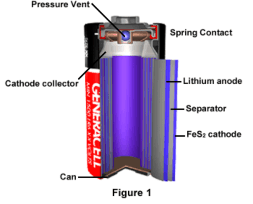
A lead acid battery is primarily made up of lead plates, sulfuric acid and water. The sulfuric acid and water solution (electrolyte) causes a chemical reaction with the lead plates to produce electrons. As the battery is used, the release of electrons causes the sulfur to rest within the lead plates. When the battery is recharged, sulfur is released from the plates and power is restored to the battery.

SLA batteries are maintenance free over the duration of their life and do not need to have water added or the gravity of the electrolyte checked. SLA batteries are constructed in a manner which ensures no electrolyte spillage, therefore making them safe for transfer and operation. In the instance that gas pressure builds up in the SLA battery, vents located on the top of the battery release the gas and automatically reseal once the pressure returns to normal levels.
![]()
SLA Battery Usage
Sealed Lead Acid batteries have many uses and can be found in a variety of products and industries. Here is an example of some common usages:
Uninteruptable Power Supplies (UPS Systems)
Emergency Lighting
Home Security Alarm Systems Septic Tank Systems
Medical & Instrumentation Products Telecommunication Systems Children's Battery Powered Riding Cars
Motorized Scooters
![]()
Battery Failure
Eventually, batteries need to be replaced because they can no longer hold a charge. One reason for battery failure is because over time sulfur builds up and coats the battery's lead plates. This is called “sulfation build-up”. Another reason for battery failure is caused by corroded lead plates. The corrosion of the plates does not allow the chemical reaction to take place, therefore no electrons are discharged.
2. Remote control
The two most common remote keyless-entry devices are:
The fob that goes on your key ring to lock and unlock your car doors (Many of these fobs also arm and disarm a car alarm system.
The small controller that hangs off your car’s sun visor to open and close the garage door
The first shows a controller chip (black) and a DIP switch (blue). A DIP switch has eight tiny switches arranged in a small package and soldered to the circuit board. By setting the DIP switches inside the transmitter, you controlled the code that the transmitter sent. The garage door would only open if the receiver’s DIP switch were set to the same pattern. This provided some level of security, but not much. Eight DIP switches provide only 256 possible combinations. That’s enough to keep several neighbors from opening each other's doors, but not enough to provide any real security.
How to Make a Remote Control Work on a Different Garage Door
Place a ladder underneath the rear section of the opener’s motor. Slide the remote into your pocket and climb the ladder.
Open the door on the back of the opener’s motor. Locate the square button labeled “Smart.” Pull the remote out of your pocket.
Press the “Smart” button, then the remote's “Open” button. If the opener has lights, they blink on then off to notify you the synchronization is complete.
3. Alarm system
Other than the family dog, the most basic burglar alarm is a simple electric circuit built into an entry way. In any circuit, whether it's powering a flashlight or a computer, electricity only flows when you give it a path between two points of opposite charge. To turn the electricity on or off, you open or close part of the circuit.
To open or close a flashlight circuit, you simply throw a switch. In a burglar alarm, the switch detects the act of intrusion - opening a door or window, for example. These sorts of alarms are divided into two categories:
In a closed-circuit system, the electric circuit is closed when the door is shut. This means that as long as the door is closed, electricity can flow from one end of the circuit to the other. But if somebody opens the door, the circuit is opened, and electricity can't flow. This triggers an alarm.
In an open-circuit system, opening the door closes the circuit, so electricity begins to flow. In this system, the alarm is triggered when the circuit is completed.
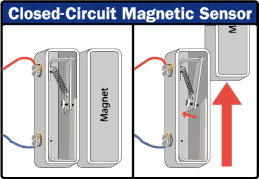
A magnetic sensor in a closed circuit consists of a few simple components. For the most basic design, you need:
a battery powering a circuit
a spring-driven metal switch built into a door frame
a magnet embedded in the door, lined up with the switch
a separately-powered buzzer with a relay-driven switch.
When the door is closed, the magnet pulls the metal switch closed so the circuit is complete. The current powers the relay’s electromagnet, so the buzzer circuit stays open. When you move the magnet by opening the door, the spring snaps the switch back into the open position. This cuts off the current and closes the relay, sounding the alarm.
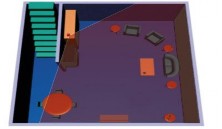
The motion detector emits radio energy into a room and monitors the reflection pattern.
An automatic door opener is an example of a radar-based motion detector. The box above the door sends out bursts of microwave radio energy (or ultrasonic sound waves), and then waits for the reflected energy to bounce back. If there is nobody in front of the door, the radio energy will bounce back in the same pattern. But if somebody enters the area, the reflection pattern is disturbed. When this happens, the sensor sends a signal and the door opens. In a security system, the sensor sends an alarm signal when the reflection pattern in a room is disturbed.
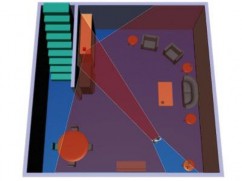
If somebody disturbs the reflection pattern, the motion detector sends an alarm signal to the control box.
Another simple design is a photo-sensor motion detector. These are the devices you might see in a store at a shopping mall. When somebody enters the store, the motion detector sounds a chime or bell. Photo-sensors have two components:
a source of focused light (often a laser beam)
a light sensor
In a home security system, you aim the beam at the light sensor, across a passageway in your house. When somebody walks between the light source and the sensor, the path of the beam is blocked briefly. The sensor registers a drop in light levels and sends a signal to the control box.
4. Matel detector
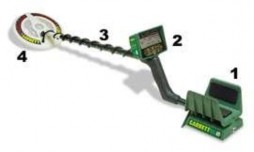
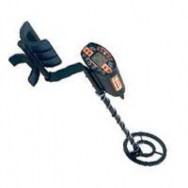
Metal-detector technology is a huge part of our lives, with a range of uses that spans from leisure to work to safety. The metal detectors in airports, office buildings, schools, government agencies and prisons help ensure that no one is bringing a weapon onto the premises. Consumer-oriented metal detectors provide millions of people around the world with an opportunity to discover hidden treasures (along with lots of junk).
Anatomy of a Metal Detector
A typical metal detector is light-weight and consists of just a few parts:
1. Stabilizer (optional) - used to keep the unit steady as you sweep it back and forth
2. Control box - contains the circuitry, controls, speaker, batteries and the microprocessor
3. Shaft - connects the control box and the coil; often adjustable so you can set it at a comfortable level for your height
4. Search coil - the part that actually senses the metal; also known as the “search head,” “loop” or “antenna”
Most systems also have a jack for connecting headphones, and some have the control box below the shaft and a small display unit above.
Operating a metal detector is simple. Once you turn the unit on, you move slowly over the area you wish to search. In most cases, you sweep the coil (search head) back and forth over the ground in front of you. When you pass it over a target object, an audible signal occurs. More advanced metal detectors provide displays that pinpoint the type of metal it has detected and how deep in the ground the target object is located.
Metal detectors use one of three technologies:
Very low frequency (VLF)
Pulse induction (PI)
Beat-frequency oscillation (BFO)
IV. EXERCISE
Mục tiêu: Kiểm tra kết quả đạt được của người học về sự hiểu biết các từ vựng chuyên môn cũng như ngữ pháp, kiến thức và kỹ năng đọc hiểu đã được học để hoàn thành các bài tập ứng dụng cũng như áp dụng vào trong môi trường làm thực tế sau khi tốt nghiệp.
1. Complete the sentences
failure Security maintenance plates battery
a. A lead acid ……….. is primarily made up of lead plates, sulfuric acid and water.
b. SLA batteries are …………….free over the duration of their life
c. When the battery is recharged, sulfur is released from the …….. and power is restored to the battery.
d. Sealed Lead Acid batteries can also be used in Home ……… Alarm Systems
e. One reason for battery ………………. is because over time sulfur builds up and coats the battery's lead plates
2. Answer the following questions
a. Why do batteries get failure?
.............................................................................................................................
.............................................................................................................................
b. What is the function of the fob?
.............................................................................................................................
.............................................................................................................................
c. What is the small controller that hangs off your car’s sun visor used for ?
.............................................................................................................................
d. How to Make a Remote Control Work on a Different Garage Door
.............................................................................................................................
.............................................................................................................................
e. How many types of alarms are there?
.................................................................................................................................
.................................................................................................................................
3. Decide True or False
a. When the door is closed, the magnet pulls the metal switch closed so the circuit is complete.
b. The motion detector stores radio energy and uncontrols the reflection pattern.
c. When you move the magnet by opening the door, the spring snaps the switch back into the open position.
d. An automatic door opener is an example of a radar-based motion detector.
e. In a security system, the sensor sends an alarm signal when the reflection pattern in a room is not disturbed.
4. Listen and Check
simple target metal detectors object sweep slowly box systems




